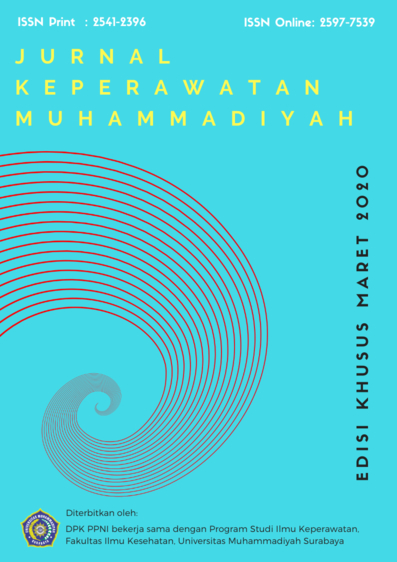Pengaruh Pursed Lips Breathing Terhadap Status Peningkatan Oksigenasi Perifer Dan Fungsi Ventilasi Paru Pada Pasien PPOK: A Literature Review
DOI:
https://doi.org/10.30651/jkm.v5i2.4325Keywords:
pursed lips breathing, Peripheral oxygenation, Lung Ventilation FunctionAbstract
Abstract
Introduction :
Respiratory disease is the enhancement problem in a world that really needs a solution. Objectives:
The purpose of this literature was conducted to evaluate the effect of Pursed Lips Breathing on Peripheral Oxygenation and Lung Ventilation Function.
Methods:
Relevant studies were searched for in 4 data bases Pubmed, Willey, Science
direct and Google Scholar, publication dates 5 years. the collected keywords were “Pursed Lips Breathingâ€, “chronic obstructive pulmonary diseaseâ€, and “oxygen saturationâ€. The search results for those keywords were 6 research articles in Pubmed, 13 research articles in Willey, 6 research articles in ScienceDirect, and 33 research articles in Google Scholar. Only 5 studies were relevant to this review.
Results: Based on the articles that have been obtained Pursed Lips Breathing is effective in increasing ventilation and Peripheral oxygenation and effective in increasing lung activity for the respiration process. As for the monitoring criteria for the effectiveness of respiration status by looking at the FEV1 and Spo2 indicator
Conclusion: The pursed lips breathing intervention is carried out continuously to the patient every day to get optimal results for the respiration process.
Keyword: pursed lips breathing, Peripheral oxygenation, Lung Ventilation Function
References
Al Ghamdi, B., Koshak, E., Ageely, H., Omer, F., Awadalla, N., & Mahfouz, A. (2019). Prevalence and factors associated with adult bronchial asthma in Aseer region, Southwestern Saudi Arabia. Annals of Thoracic Medicine, 14(4), 278. https://doi.org/10.4103/atm.atm_67_19
Babu, B., Centre, M. C., Ealias, J., & Venunathan, A. (2016). Pursed Lip Breathing Exercise – a Self-Management Approach Anveshana International Journalof Research in Pharmacy and Life Sciences Pursed Lip Breathing Exercise – a Self-Management Approach Towards Shortness of Breath, (September).
Cabral, L. F., D’Elia, T. D. C., Marins, D. D. S., Zin, W. A., & Guimarães, F. S. (2015). Pursed lip breathing improves exercise tolerance in COPD: a randomized crossover study. European Journal of Physical and Rehabilitation Medicine, 51(1), 79–88. Retrieved from http://www.ncbi.nlm.nih.gov/pubmed/24691248
D., von B., S.D., K., J., W., E., S., O., A., C., G., … U., W. (2018). Speech-guided breathing retraining in asthma: A randomised controlled crossover trial in real-life outpatient settings. Trials, 19(1), 1–8. https://doi.org/10.1186/s13063-018-2727-z LK -
Effing, T. W., Bourbeau, J., Vercoulen, J., Apter, A. J., Coultas, D., Meek, P., … Partridge, M. R. (2012). Self-management programmes for COPD : Moving forward. https://doi.org/10.1177/1479972311433574
Garrod, R., & Mathieson, T. (2013). Pursed lips breathing. Chronic Respiratory Disease, 10(1), 3–4. https://doi.org/10.1177/1479972312472689
Iribarren, C., Tolstykh, I. V., & Eisner, M. D. (2004). Are patients with asthma at increased risk of coronary heart disease? International Journal of Epidemiology, 33(4), 743–748. https://doi.org/10.1093/ije/dyh081
Kementerian Kesehatan RI Badan Penelitian dan Pengembangan. (2018). Hasil Utama Riset Kesehatan Dasar. Kementrian Kesehatan Republik Indonesia, 1–100. https://doi.org/1 Desember 2013
Lõpez-Campos, J. L., Tan, W., & Soriano, J. B. (2016). Global burden of COPD. Respirology, 21(1), 14–23. https://doi.org/10.1111/resp.12660
Mendes, L. P., Moraes, K. S., Hoffman, M., Vieira, D. S., Ribeiro-Samora, G. A., Lage, S. M., … Parreira, V. F. (2019). Effects of Diaphragmatic Breathing With and Without Pursed-Lips Breathing in Subjects With COPD. Respiratory Care, 64(2), 136–144. https://doi.org/10.4187/respcare.06319
Moher, D., Liberati, A., Tetzlaff, J., & Altman, D. G. (2014). Checklist from: Preferred Reporting Items for Systematic Reviews and Meta-Analyses: The PRISMA Statement. Annals of Internal Medicine, 151(4), 264–269. https://doi.org/10.1371/journal.pmed1000097
Ntritsos, G., Franek, J., Belbasis, L., Christou, M. A., Markozannes, G., Altman, P., … Evangelou, E. (2018). Gender-specific estimates of COPD prevalence: A systematic review and meta-analysis. International Journal of COPD, 13, 1507–1514. https://doi.org/10.2147/COPD.S146390
Oemiati, R. (2013). Kajian Epidemiologis Penyakit Paru Obstruktif Kronik (Ppok), 23(2 Jun), 82–88. https://doi.org/10.22435/mpk.v23i2.3130.82-88
Pereira De Araujo, C. L., Karloh, M., Dos Reis, C. M., Palú, M., & Mayer, A. F. (2015). Pursed-lips breathing reduces dynamic hyperinflation induced by activities of daily living test in patients with chronic obstructive pulmonary disease: A randomized crossover study. Journal of Rehabilitation Medicine, 47(10), 957–962. https://doi.org/10.2340/16501977-2008
Ryynänen, O. P., Soini, E. J., Lindqvist, A., Kilpeläinen, M., & Laitinen, T. (2013). Bayesian predictors of very poor health related quality of life and mortality in patients with COPD. BMC Medical Informatics and Decision Making, 13(1). https://doi.org/10.1186/1472-6947-13-34
Sakhaei, S., Sadagheyani, H. E., Zinalpoor, S., Markani, A. K., & Motaarefi, H. (2018). The Impact of Pursed-lips Breathing Maneuver on Cardiac, Respiratory, and Oxygenation Parameters in COPD Patients. Open Access Macedonian Journal of Medical Sciences, 6(10), 1851–1856. https://doi.org/10.3889/oamjms.2018.407
Singh, J. (2013). Critical appraisal skills programme. Journal of Pharmacology and Pharmacotherapeutics, 4(1), 76–77. https://doi.org/10.4103/0976-500X.107697
Thomas, B. H., Ciliska, D., Dobbins, M., & Micucci, S. (2004). A process for systematically reviewing the literature: Providing the research evidence for public health nursing interventions. Worldviews on Evidence-Based Nursing, 1(3), 176–184. https://doi.org/10.1111/j.1524-475X.2004.04006.x
Webley, W. C., & Hahn, D. L. (2017). Infection-mediated asthma: Etiology, mechanisms and treatment options, with focus on Chlamydia pneumoniae and macrolides. Respiratory Research, 18(1), 1–12. https://doi.org/10.1186/s12931-017-0584-z
Yekefallah, L., Zohal, M. A., Keshavarzsarkar, O., Barikani, A., & Gheraati, M. (2019). Comparing the effects of upper limb and breathing exercises on six-minute walking distance among patients with chronic obstructive pulmonary disease: a three-group randomized controlled clinical trial. Advances in Respiratory Medicine, 87(2), 77–82. https://doi.org/10.5603/ARM.2019.0013
Downloads
Published
Issue
Section
License
- Penulis tetap memegang hak atas karyanya dan memberikan hak publikasi pertama kepada jurnal ini yang secara simultan karya tersebut dilisensikan di bawah:Â Creative Commons Attribution-ShareAlike 4.0 International (CC BY-SA 4.0)













